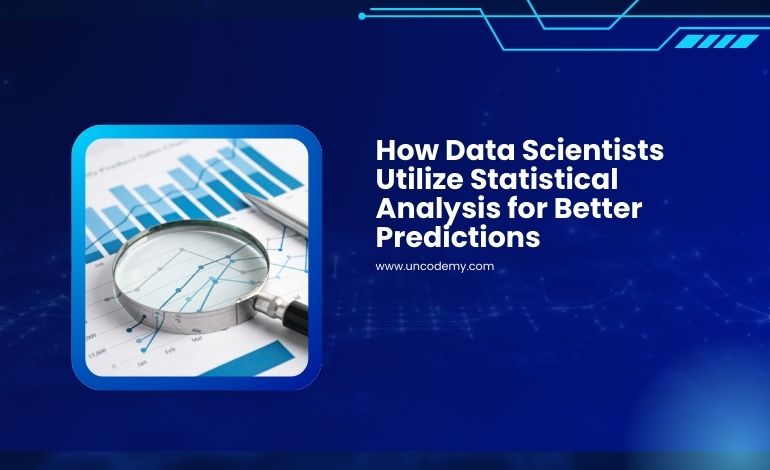Statistical analysis lies at the heart of data science, providing the framework for making data-driven decisions and accurate predictions. By leveraging statistical techniques, data scientists can extract insights from raw data, uncover hidden patterns, and forecast future trends. In this article, we explore the core statistical methods that data scientists use and discuss how artificial intelligence (AI) is transforming the tools they rely on to achieve better predictions.
The Role of Statistical Analysis in Data Science
Statistical analysis involves collecting, analyzing, interpreting, and presenting data to make informed decisions. For data scientists, statistical methods are indispensable in understanding the underlying structure of data, identifying relationships between variables, and building predictive models.
Key applications of statistical analysis in data science include:
- Descriptive Statistics: Summarizing and describing data characteristics.
- Inferential Statistics: Drawing conclusions and making inferences about a population based on sample data.
- Predictive Modeling: Building models to predict future outcomes based on historical data.
- Hypothesis Testing: Validating assumptions and testing relationships between variables.
Essential Statistical Techniques Used by Data Scientists
1. Descriptive Statistics
Descriptive statistics provide a snapshot of the dataset, helping data scientists understand its basic features.
Key Metrics:
- Mean, Median, and Mode: Measures of central tendency.
- Standard Deviation and Variance: Indicators of data spread.
- Percentiles and Quartiles: Insights into data distribution.
Applications:
- Summarizing customer demographics.
- Understanding sales trends over time.
2. Regression Analysis
Regression analysis is a powerful statistical tool for modeling the relationship between variables.
Types of Regression:
- Linear Regression: Examines the relationship between two variables.
- Multiple Regression: Explores the impact of several predictors on an outcome.
- Logistic Regression: Predicts categorical outcomes (e.g., success/failure).
Applications:
- Predicting house prices based on features like location and size.
- Estimating customer churn probability.
3. Probability and Distribution Analysis
Probability concepts are fundamental in assessing the likelihood of events, while distribution analysis provides insights into how data points are spread.
Common Distributions:
- Normal Distribution: Common in natural phenomena.
- Binomial Distribution: Useful for binary outcomes.
- Poisson Distribution: Models rare events.
Applications:
- Risk assessment in financial portfolios.
- Analyzing product defect rates.
4. Hypothesis Testing
Hypothesis testing evaluates whether a claim about a dataset is statistically valid.
Key Concepts:
- Null Hypothesis (H0): Assumes no effect or relationship.
- Alternative Hypothesis (H1): Contradicts the null hypothesis.
- P-Value: Determines statistical significance.
- Confidence Intervals: Measures reliability of an estimate.
Applications:
- Comparing the effectiveness of marketing campaigns.
- Testing the impact of a new product feature on user engagement.
5. Cluster Analysis
Cluster analysis groups similar data points, enabling segmentation and pattern recognition.
Techniques:
- K-Means Clustering: Partitions data into K groups.
- Hierarchical Clustering: Builds a tree-like structure of data groups.
Applications:
- Customer segmentation for personalized marketing.
- Identifying patterns in healthcare data.
6. Time Series Analysis
Time series analysis examines data points collected over time to identify trends, seasonality, and cycles.
Methods:
- ARIMA (Auto-Regressive Integrated Moving Average): Models time-dependent data.
- Exponential Smoothing: Captures trends and seasonal variations.
Applications:
- Forecasting stock prices.
- Predicting energy consumption.
How AI is Transforming Statistical Analysis Tools
Artificial intelligence is revolutionizing statistical analysis by automating complex processes, enhancing accuracy, and enabling the analysis of vast datasets in real time. Here are some key strengths of AI-powered tools:
1. Automated Data Cleaning
AI simplifies the data cleaning process by detecting anomalies, correcting errors, and handling missing values.
Example Tools:
- Trifacta: Automates data preparation workflows.
- DataRobot: Offers AI-driven data cleaning capabilities.
Key Strength: Reduces time spent on preprocessing and ensures high-quality data.
2. Advanced Predictive Modeling
AI enhances predictive modeling by utilizing advanced algorithms and deep learning techniques.
Example Tools:
- TensorFlow: Enables the creation of neural networks for predictions.
- H2O.ai: Simplifies machine learning model development.
Key Strength: Improves model accuracy and scalability.
3. Enhanced Data Visualization
AI-powered visualization tools enable intuitive data exploration and insights generation.
Example Tools:
- Tableau with AI Integration: Offers natural language querying and AI-powered insights.
- Power BI: Provides AI-assisted dashboards and recommendations.
Key Strength: Makes data accessible to both technical and non-technical users.
4. Real-Time Analytics
AI enables the processing and analysis of streaming data for instant decision-making.
Example Tools:
- Apache Kafka: Handles real-time data pipelines.
- Microsoft Azure Stream Analytics: Offers real-time data analysis and visualization.
Key Strength: Supports industries requiring immediate insights, such as finance and healthcare.
5. Democratization of Analytics
AI-powered platforms like AutoML allow users with minimal coding experience to build complex models.
Key Strength: Broadens access to data analytics and reduces dependency on specialized data scientists.
Conclusion
Statistical analysis is the backbone of data science, empowering professionals to make better predictions and data-driven decisions. From descriptive statistics to predictive modeling, these techniques enable data scientists to extract meaningful insights and drive innovation. The integration of AI has further transformed statistical tools, enhancing efficiency, accuracy, and accessibility.
To build expertise in these methods and explore cutting-edge tools, consider enrolling in a data analytics course certification in Delhi, Pune, Noida and other cities in India, designed to provide hands-on experience and practical knowledge.
Also Read
- ► Modern Layer: Women Hoodies for Everyday Glamour
- ► Why Movers and Packers are Essential for a Smooth Move
- ► Cozy to Chic Hoodies for Every Mood
- ► Get Instant Cash for Silver: Your Ultimate Guide to Selling Silver in 2025
- ► Your Trusted Essential Oil Supplier
- ► What are the top trends in porcelain wall tiles for 2025?
- ► Essential Hoodie Comfortable Fabrics
- ► How to Choose the Right Digital and Creative Agency in the San Francisco Bay Area
- ► Everyone Needs a Versatile Hoodie Wardrobe
- ► Essential Hoodie Online Store in the UK
- ► Exhibition Stand Design Builder Company In Berlin
- ► Who Should Wear Neelam Stone?
- ► 7 Expert Tips to Upgrade Old Toilet Cubicles into a Modern Washroom Haven
- ► Wholesale Adult Long Sleeve T-Shirts: Style, Comfort, and Versatility in Bulk
- ► Bumrungrad Bangladesh: Your Destination for World-Class Healthcare





